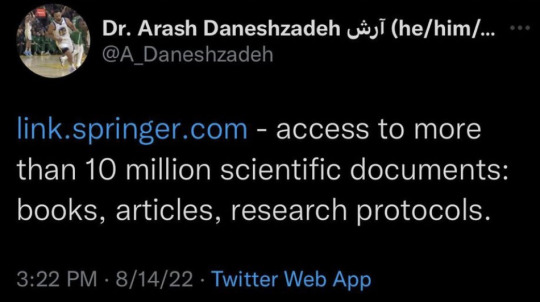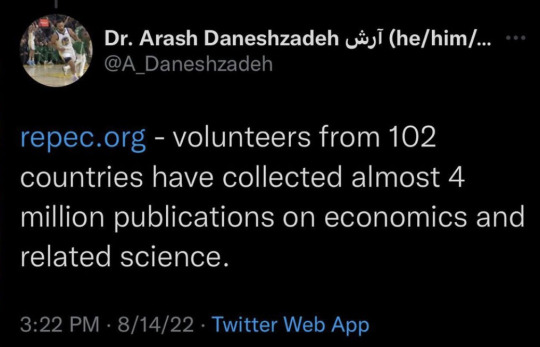#Research Tools
Explore tagged Tumblr posts
Text
Sick of seeing reviews in your JSTOR search results?
While we love a review every now and then, we understand they may not be the most helpful in every case.
Enter: Advanced Search on JSTOR.
There's a nifty section there titled "Narrow Results," where you can select the kind of results you're in the market for.

Detailed instructions for searching and citation are available on our Support website!
#if i had a penny for everyone who didn't know about this... i'd use all the pennies to promote this tip far and wide#jstor#research#academic research#academia#students#education#gradblr#phdblr#studyblr#research tools#research tips
235 notes
·
View notes
Text
If I’m being honest, the most useful skill for hacking is learning to do research. And since Google’s search is going to shit, allow me to detail some of the methods I use to do OSINT and general research.
Google dorking is the use of advanced syntax to make incredibly fine-grained searches, potentially exposing information that wasn’t supposed to be on the internet:
Some of my go-to filters are as follows:
“Query” searches for documents that have at least one field containing the exact string.
site: allows for a specific site to be searched. See also inurl and intitle.
type: specifies the tor of resource to look for. Common examples are log files, PDFs, and the sitemap.xml file.
Metasearch engines (such as SearxNG) permit you to access results from several web-crawlers at once, including some for specialized databases. There are several public instances available, as well as some that work over tor, but you can also self-host your own.
IVRE is a self-hosted tool that allows you to create a database of host scans (when I say self-hosted, I mean that you can run this in a docker container on your laptop). This can be useful for finding things that search engines don’t show you, like how two servers are related, where a website lives, etc. I’ve used this tool before, in my investigation into the Canary Mission and its backers.
Spiderfoot is like IVRE, but for social networks. It is also a self-hosted database. I have also used this in the Canary Mission investigation.
Some miscellaneous websites/web tools I use:
SecurityTrails: look up DNS history for a domain
BugMeNot: shared logins for when creating an account is not in your best interest.
Shodan/Censys: you have to make an account for these, so I don’t usually recommend them.
OSINT framework: another useful index of tools for information gathering.
37 notes
·
View notes
Text
For Australian politics. If you want to know if a politician has a potential conflict of interest (eg: they're supposed to pass legislation restricting approval of coal mines and oh how fascinating, it seems the biggest mining executives in the country have taken a sudden interest in wining and dining and giving other totally-no-strings-attached gifts to this politician. Huh.) you can check for that here. Read the instructions on how to use it effectively before proceeding.
#straya#australia#auspol#australian politics#australian government#election research tools#political research tools#research#research tools#not transformers
3 notes
·
View notes
Text
doing some research for a fic and i stumbled across this project from the nypl. what's on the menu is the ongoing attempt to digitise their collection of nearly 45,000 restaurant menus and it's unbelievably cool. they go back to the mid 19th century and you can browse by decade or by unique dish. they're also looking for help to transcribe to make all their menus searchable!
#writing tools#research tools#fan fiction#writing resources#i'm obsessed with this actually#as a food nerd and a recovering historian
3 notes
·
View notes
Text
How to Access Exclusive Research Archives Online
In the digital age, exclusive research archives have become invaluable resources for academics, professionals, and curious minds alike.
In the digital age, exclusive research archives have become invaluable resources for academics, professionals, and curious minds alike. These archives house a wealth of information, often containing rare and comprehensive collections that are not readily available to the general public. Accessing these archives can seem daunting, but with the right approach, it is entirely feasible. Here’s a…

View On WordPress
#Academic Databases#Academic Research#Accessing Archives#Digital Archives#Digital Collections#Digital Libraries#Exclusive Research Archives#Government Archives#Historical Documents#Interlibrary Loan#Library Archives#Metadata in Archives#Online Databases#Online Research#Open Access Resources#Research Navigation#Research Resources#Research Tools#Scholarly Research#University Archives
3 notes
·
View notes
Text
5 Ways Experience Sampling Can Help Your Research Process
Understanding the complexities of human experience in natural settings can be challenging in psychological and behavioral research.
This is where you can utilize Experience Sampling Methodology or ESM. ESM, also known as Ecological Momentary Assessment (EMA), involves collecting data from participants in real time as they go about their daily lives.

Whether you are conducting qualitative or quantitative research, integrating ESM or EMA can enrich your study and yield more profound insights.
Here are five ways it can help improve your research process.
Capture Real-Time Data
Traditional surveys rely on retrospective recall, which is subject to memory biases and distortions. ESM allows researchers to capture data in real-time or near real-time. Participants are prompted to record their thoughts, feelings, or behaviors as they happen, providing more accurate insights and reflections on their immediate experiences.
Example Application: In studying mood disorders, participants can be prompted to rate their current mood at various intervals. This can help identify patterns and triggers that may not be remembered or recognized later.
Understand Contextual Influences
Human behavior doesn't occur in a vacuum. External factors like environment, company, or daily activities can significantly influence thoughts, emotions, and actions. ESM can incorporate context-based questions, helping researchers understand how specific settings impact behavior.
Example Application: In addiction research, understanding how social settings affect cravings can offer insights into high-risk environments. Participants can record their cravings in response to being alone, with friends, or in other situations.
Capture Variability and Dynamics Over Time
Experience sampling provides longitudinal data, which allows researchers to explore how psychological states fluctuate over time. The data can uncover patterns of stability, change, and the dynamic interplay between different variables.
Example Application: In workplace studies, researchers can assess how job satisfaction and stress levels fluctuate throughout the workweek. This can help identify critical points for intervention, such as Monday morning or just before a big project deadline.
Enhance Personalization and Customization
ESM can be tailored to individual participants' needs and contexts, creating a personalized research experience. This enhances participant engagement and data quality. Researchers can adapt prompts based on previous responses or participant characteristics.
Example Application: In health behavior research, participants attempting weight loss could receive personalized motivational prompts when their mood ratings fall below a certain threshold.
Minimize Recall Bias and Social Desirability Bias
Since ESM gathers data frequently and in real-time, it reduces reliance on participants' memories, minimizing recall bias. Moreover, the method helps alleviate social desirability bias by encouraging participants to record their experiences naturally and spontaneously.
Example Application: In dietary studies, participants are prompted to record their food intake immediately after consumption. This reduces the likelihood of forgetting what they ate or underreporting less healthy food choices.
Experience Sampling Methodology offers a dynamic and nuanced approach to capturing the complexities of human behavior and psychological states. By incorporating ESM into your research process, you can obtain more accurate, contextualized, and comprehensive data that ultimately leads to deeper insights and more effective interventions.
If you want to learn more about the Experience Sampling Method, visit ExpiWell for help getting started. You can also email them at [email protected] for a FREE consultation. Start revolutionizing today!
2 notes
·
View notes
Text
Maximizing Efficiency: Best Practices for Using Sequencing Consumables

By implementing these best practices, researchers can streamline sequencing workflows, increase throughput, and achieve more consistent and reproducible results in genetic research. Sequencing Consumables play a crucial role in genetic research, facilitating the preparation, sequencing, and analysis of DNA samples. To achieve optimal results and maximize efficiency in sequencing workflows, it's essential to implement best practices for using these consumables effectively.
Proper planning and organization are essential for maximizing efficiency when using Sequencing Consumables. Before starting a sequencing experiment, take the time to carefully plan out the workflow, including sample preparation, library construction, sequencing runs, and data analysis. Ensure that all necessary consumables, reagents, and equipment are readily available and properly labeled to minimize disruptions and delays during the experiment.
Optimizing sample preparation workflows is critical for maximizing efficiency in sequencing experiments. When working with Sequencing Consumables for sample preparation, follow manufacturer protocols and recommendations closely to ensure consistent and reproducible results. Use high-quality consumables and reagents, and perform regular quality control checks to monitor the performance of the workflow and identify any potential issues early on.
Utilizing automation technologies can significantly increase efficiency when working with Sequencing Consumables. Automated sample preparation systems and liquid handling robots can streamline repetitive tasks, reduce human error, and increase throughput. By automating sample processing and library construction workflows, researchers can save time and resources while improving consistency and reproducibility in sequencing experiments.
Get More Insights On This Topic: Sequencing Consumables
#Sequencing Consumables#DNA Sequencing#Laboratory Supplies#Genetic Analysis#Next-Generation Sequencing#Molecular Biology#Research Tools#Bioinformatics
2 notes
·
View notes
Text
youtube
✨ Streamline Your Research – Stay Organized & Focused! ✨
Say goodbye to messy notes, boost your research efficiency and upgrade your literature review process! 📝🔍
Grab yours now!
#Research Planner#Study Organizer#Productivity Tool#Academic Planner#Research Tracker#Google Sheets Template#Spreadsheet Planner#Digital Planner#Data Organization#Project Management#Research Tools#Writing Organizer#Study Tools#Work Organization#Information Management#Literature Review#Literature Research#digitalgoodsf#digital products#google sheets#Youtube
0 notes
Text
youtube
#Heterologous expression#Annexin A8#protein purification#specific antibodies#immunology#cell signaling#apoptosis#cancer research#neurodegenerative diseases#antibody generation#molecular biology#immunohistochemistry#Western blot#ELISA#phospholipid binding#protein function#biotechnology#research tools#biomedical research#scientific innovation.#Youtube
0 notes
Note
is there any manual on how to navigate jstor? I'm a bit lost trying to use it
Hi there! It can definitely be a little daunting to dive into JSTOR at first glance.
We have a LibGuide available with some brief info to help you get started.
149 notes
·
View notes
Text
Boosting the Signal


refseek.com

www.worldcat.org/

link.springer.com

http://bioline.org.br/

repec.org

science.gov

pdfdrive.com
305K notes
·
View notes
Text
AI tools: You should try Google Notebook LLM
Here’s an AI tool that I think you should definitely try. It was recommended to me by my friend Severin Sorenson, host of the Arete podcast, author of 4 books on using AI in business (and my go-to expert on the world of AI tools, better prompts, image creation). https://notebooklm.google What does it do? Google Notebook LLM is your personalised AI research assistant. You upload your sources…
0 notes
Text
The Future Of Spirit Boxes In The Age Of Digital Broadcasting JUNE 25, 2023 1:00 AM ‐ GHOST HUNTING … Read more at https://www.higgypop.com/news/the-future-of-spirit-boxes-in-the-age-of-digital-broadcasting/
0 notes
Text
Explore the Zeromaze by VJ Instruments
https://www.vjinstruments.com/products/zeromaze/
Discover the innovative Zeromaze from VJ Instruments, designed to provide precise and efficient solutions for your laboratory needs. Click to learn more about its advanced features and benefits for researchers.
0 notes
Text
How AI Improves Risk Assessment in Financial and Corporate Research
In the current financial environment, which is fast-paced the ability to measure risks accurately and efficiently is essential. As businesses navigate the complex world of finance and complex financial markets, the introduction technology such as Artificial intelligence (AI) has transformed risk assessment processes for corporate and financial research. Photon Insights stands out as the leader in making use of AI technology to boost these vital functions, offering tools that do not just improve accuracy, but also enable more informed decision-making.
The Importance of Risk Assessment
The process of risk assessment involves a approach to identifying, analyzing and addressing possible threats that could affect the financial health of an organization. For corporate and financial research, a sound risk assessment can help stakeholders comprehend the risks of volatility in markets as well as operational failures, defaults on credit as well as regulatory compliance concerns. A thorough risk assessment enables companies to make better choices, efficiently allocate resources and minimize the potential loss.
Challenges in Traditional Risk Assessment
Traditional risk assessment techniques typically use historical data and manual processes. These are time-consuming and susceptible to human errors. The main challenges are:
1. Data Overload Financial institutions are flooded with huge amounts of information from a variety of data sources. This makes it hard to gain relevant insights.
2. Lagging Indices Traditional risk assessment usually depends on lagging indicators which could not accurately predict the future risk, which can lead to the use of reactive strategies rather than proactive.
3. Subjectivity and bias Human analysts could cause bias in their assessments, affecting the objectivity of risk assessments and ultimately leading to poor decision-making.
4. Inefficiency Manual processes can drag the timeframe for assessment and make firms more exposed to rapidly changing market conditions.
AI-Powered Risk Assessment
AI technologies, specifically the use of machine learning as well as natural language processing provide innovative solutions to these problems. Through automating data analysis and providing prescriptive insight, AI significantly enhances the risk assessment process.
Key Benefits of AI in Risk Assessment
1. Enhanced Processing of Data AI algorithms can analyze massive data sets quickly, identifying patterns and patterns that analysts might miss. This allows companies to make use of real-time data in more precise risk assessments.
2. Predictive Analytics: AI can predict future dangers by studying the past and identifying patterns. This proactive approach lets companies to anticipate possible problems and to take preventive steps.
3. Automating Routine Tasks Automating repetitive tasks, like data collection or preliminary analysis AI lets human analysts concentrate on higher-order strategic thinking and making decisions.
4. Bias Protection AI systems are created to eliminate biases in human analyses and provide more accurate risk assessment. With the help of data-driven insights companies can improve the credibility of their assessments.
5. Continuous Learning: AI systems improve over time through learning from the new inputs of data which makes risk assessments more precise and a reflection of current market conditions.
Photon Insights: Transforming Risk Assessment
Photon Insights illustrates the efficient integration of AI into corporate and financial research. With advanced analysis and risk assessment tools this platform allows organizations to improve their decision-making process. Let’s see what Photon Insights is transforming risk assessment:
1. Comprehensive data Integration Photon Insights aggregates data from a variety of sources, such as the financial report, trends in markets as well as news reports. This method of integration allows organizations to get a complete understanding of risks.
2. Real-Time Analytics The platform provides real-time data that helps businesses keep ahead of changes in the market. With the latest information available firms can modify their strategies quickly, while limiting the risk of being exposed to.
3. User-Friendly Interface* Photon Insights offers an intuitive interface that makes it simple for analysts and decision makers to use the platform. This ease of use encourages adoption and helps facilitate collaboration between teams.
4. Customizable risk models Businesses can modify risk assessment models to meet their particular needs. Photon Insights allows users to develop custom algorithms that reflect their own risk profile which can enhance the usefulness of the information.
5. “Scalability”: as businesses grow, their risk management requirements change. Photon Insights is designed to grow with businesses, making sure that they have the right tools to effectively manage risk as they grow.
Real-World Applications
The use to AI for risk analysis using Photon Insights is already yielding substantial benefits to various sectors. For instance:
“Banking and Finance Financial institutions use automated risk management tools that assess credit risk more precisely and result in more effective lending decisions and lower default rates.
Insurance : Insurance companies employ AI to determine the risk of underwriting through the analysis of applicant data as well as historical claims, which results in more precise premium pricing.
Corporate Governance companies are implementing AI to assess operational risks, compliance concerns along with market dynamic, improving general corporate management. Future Implications
Future risk assessments in corporate and financial studies will change as technology advances AI technology. As companies increasingly depend on AI to make decisions, a number of tendencies are expected to be observed:
1. Integration between AI as well as humans Insight : Although AI will play an important role in the analysis of data but human judgment will be vital in the process of understanding results and making strategic choices. Combining AI capabilities with human insight will provide more efficient risk management.
2. Increased Regulatory scrutiny: As AI becomes more commonplace in risk assessment, regulators will likely to establish stricter guidelines regarding the use of AI. Companies must be ready to show transparency and accountability when using AI in their processes.
3. Expanding into New Markets : As AI technology advances its applications will go beyond traditional financial industries and offer the latest risk assessment tools to new markets and industries.
4. Focus On Ethical AI: In order to ensure ethical use of AI is of paramount importance. The organizations will have to priorities transparency, accountability, fairness and transparency when developing their AI models in order to ensure the trust of their stakeholders.
Conclusion
AI is fundamentally altering the risk assessment landscape in corporate and financial research. Through automating data analysis, delivering the ability to predict and improve the objectivity of research, AI empowers organizations to make better decisions in a complex world. Photon Insights stands at the forefront of this change by providing cutting-edge tools that help companies manage risk effectively and strategically. As the use of AI is evolving and grow, companies that embrace these advances are better prepared to succeed in the ever-changing world of finance, ensuring longevity and success.
0 notes
Text
How can the EMA App Help Various Fields of Research?
Ecological Momentary Assessment (EMA) refers to a research method that captures real-time data in natural environments, providing insights into behaviors, moods, and experiences as they occur. Unlike traditional research methods like surveys or interviews, which rely on retrospective recall, EMA gathers data now, offering a more accurate reflection of individuals' lives.
In contemporary research, EMA has revolutionized data collection by enhancing ecological validity and minimizing recall bias. Researchers across disciplines utilize an EMA app to delve deeper into human behaviors, responses to interventions, and environmental influences. This methodological approach has broad applications across various fields.
In this article, you will learn the different practical applications of Ecological Momentary Assessment apps across various fields.
Practical Applications of EMA Across Different Fields

1) Psychology and Psychiatry
EMA is instrumental in psychology and psychiatry as it tracks real-time mood fluctuations and behaviors. This method offers insights into the triggers of psychological conditions such as anxiety or depression, which can vary widely throughout the day or in response to specific environmental stimuli.
By capturing these nuances, EMA enables clinicians and researchers to develop more effective therapeutic interventions tailored to individual needs. For example, EMA app data can reveal patterns in mood changes associated with certain activities or social interactions, guiding the implementation of behavioral therapies or medication schedules that align with patients' daily routines.
2) Health and Medicine
EMA is crucial in monitoring symptoms, adherence to treatment regimens, and lifestyle factors impacting health outcomes in healthcare. By collecting data on symptoms such as pain levels, fatigue, or medication side effects in real-time, healthcare providers can make timely adjustments to treatment plans, improving patient comfort and compliance.
EMA also facilitates personalized healthcare approaches by identifying individual patterns in health behaviors and responses to interventions. For instance, in chronic disease management, EMA data can highlight fluctuations in symptoms that may indicate the need for medication adjustments or lifestyle modifications, enhancing overall patient care and quality of life.
3) Public Health
EMA contributes significantly to public health research by studying health behaviors and their environmental influences on disease prevention strategies. For example, in epidemiological studies, EMA can track physical activity patterns, dietary habits, or exposure to environmental pollutants in real-time, providing insights into factors contributing to chronic diseases like obesity or cardiovascular disorders.
Ecological Momentary Assessment app data on social interactions and community behaviors can also inform public health policies to promote healthier lifestyles or mitigate disease transmission. By understanding how environmental factors such as air quality or neighborhood design impact health behaviors, public health officials can develop targeted interventions to improve population health outcomes.
In the study “The Hazards of Daily Stressors: Comparing the Experiences of Sexual and Gender Minority Young Adults to Cisgender Heterosexual Young Adults During the COVID-19 Pandemic”, the researchers used the EMA approach to learn how COVID affects people, especially gender minorities, and help authorities improve public health.
4) Education
EMA examines learning processes, engagement levels, and factors influencing student performance in educational settings. By capturing real-time data on students' academic behaviors, such as study habits, attention span, and interactions with learning materials, EMA helps educators identify effective teaching strategies and tailor instructional approaches to individual learning styles.
For example, EMA can reveal periods of high engagement or distraction during learning activities, guiding the design of adaptive learning technologies or interventions that optimize student learning experiences. Additionally, EMA data on student motivation and emotional states can support efforts to create supportive learning environments and enhance educational outcomes across diverse student populations.
5) Social Sciences
EMA is invaluable in the social sciences for exploring social interactions, cultural influences, and behavioral responses in natural settings. By collecting real-time data on interpersonal dynamics, communication patterns, and artistic practices, the EMA or Experience Sampling app enables researchers to study societal dynamics and cultural variations with greater accuracy and depth.
For example, EMA data can illuminate how social norms or cultural beliefs shape individuals' behaviors and decision-making processes, providing insights into social phenomena such as conformity, leadership dynamics, or community resilience. By understanding these dynamics, social scientists can develop evidence-based interventions and policies that promote social cohesion and address complex social challenges.
6) Environmental Studies
In environmental research, EMA monitors ecological behaviors, responses to environmental changes, and human impacts on ecosystems. EMA supports conservation efforts and sustainable development practices by capturing real-time data on biodiversity, habitat use, or human interactions with natural environments.
For example, EMA data can track wildlife movements responding to climate fluctuations or human activities, informing habitat conservation strategies and ecosystem management plans.
Also, EMA enables researchers to assess the effectiveness of environmental policies and initiatives by measuring community perceptions, behaviors, and attitudes toward conservation practices. By integrating an EMA app into ecological studies, researchers can foster interdisciplinary collaborations and leverage data-driven approaches to address pressing environmental challenges.
7) Business
EMA helps businesses understand consumer behaviors, preferences, and decision-making processes in real-world contexts. EMA collects real-time data on shopping habits, product preferences, or customer satisfaction levels, enabling marketers and business analysts to identify market trends, optimize marketing strategies, and enhance product development efforts.
For example, EMA data can reveal patterns in consumer purchasing behaviors across different demographic groups or geographic regions, guiding businesses in tailoring their offerings and promotional campaigns to meet diverse customer needs. As such, EMA facilitates rapid feedback loops and iterative improvements in business strategies by providing timely insights into consumer reactions to new products or marketing initiatives.
8) Sports Psychology
EMA optimizes athlete performance strategies by tracking training routines, psychological states during competitions, and factors influencing peak performance. By collecting data on athletes' physical exertion, recovery times, and emotional responses in real time, EMA helps sports psychologists and coaches identify optimal training regimens and performance enhancement techniques.
For example, EMA data can reveal patterns in athletes' stress levels or motivational triggers before competitions, informing personalized coaching interventions that optimize mental resilience and physical performance outcomes. Moreover, EMA supports injury prevention efforts by monitoring athletes' biomechanical movements and identifying potential risk factors during training sessions or competitive events.
This study, "The Role of Affect and Exercise Goals in Physical Activity Engagement in Younger and Older Adults," also uses the EMA method to show how exercising can affect physical performance.
9) Urban Planning
EMA tracks commuting patterns, transportation choices, and urban behaviors, informing urban planners about community needs, traffic management, and sustainable city design. By collecting data on residents' travel habits, mobility patterns, and environmental preferences in real-time, EMA enables urban planners to optimize transportation infrastructure, reduce traffic congestion, and promote sustainable modes of travel.
For example, EMA app data can inform the development of pedestrian-friendly neighborhoods or bike-sharing programs that enhance mobility options and improve air quality in urban areas. Nonetheless, EMA supports community engagement by soliciting feedback on urban planning initiatives and fostering collaborative decision-making processes among stakeholders.
10) Criminal Justice
In criminal justice research, EMA studies offender behaviors, compliance with interventions, and crime prevention strategies, enhancing rehabilitation programs and community safety. By collecting data on offenders' daily routines, social interactions, and adherence to probation conditions in real-time, EMA helps criminal justice professionals identify risk factors for recidivism and tailor rehabilitative interventions to individual needs.
For example, EMA data can reveal patterns in offenders' compliance with court-ordered treatments or community service requirements, informing probation officers' supervision strategies and promoting successful reintegration into society.
Therefore, Ecological Momentary assessment apps support crime prevention efforts by evaluating the effectiveness of intervention programs and informing evidence-based policies that reduce crime rates and enhance public safety.
Choose the EMA App for Your Study
If you need research software, contact ExpiWell to learn more about their Experience Sampling and Ecological Momentary Assessment app feature, which can help your study.
You can contact them today to learn how they can help your research!
0 notes